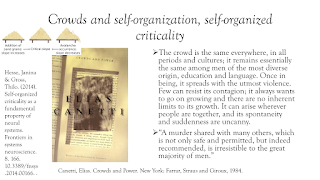10 Things Wrong With Environmental Thinking
...(and what we can do about them). Although these posts are primarily sketches for a book project on environmental critique I will also post from several other ongoing projects.
Friday, May 17, 2024
Crowds and Power - Worth a re-read
Wednesday, January 27, 2021
Can we restore nature? In seeking a means to heal our wounded planet, we should look to the painstaking, cautious craft of art conservation
It is our sad lot that we love perishable things: our friends, our parents, our mentors, our partners, our pets. Those of us who incline to nature draw this consolation: most lovely natural things – the forests, the lakes, the oceans, the reefs – endure at scales remote from individual human ones. One meaning of the Anthropocene is that we must witness the unravelling of these things too. A tree we loved in childhood is gone; a favourite woodlot is felled; a local nature preserve invaded, eroded and its diversity diminished; this planet is haemorrhaging species.
When a rare Panamanian frog was named in 2005 for George Rabb, an eminent herpetologist and friend to many in the Chicago conservation community, we celebrated this newly named animal. By the time he died in 2017, Rabb’s fringe-limbed frog (Ecnomiohyla rabborum) was assumed extinct in the wild.
Read on here
Monday, May 4, 2020
The Badgers of Montpelier Hill
 When I was a child growing up in Dublin, a friend dropped her pet hamster on the kitchen floor. The animal survived but thereafter he could only walk in circles. As the hamster got older, the circles got wider but like a ship permanently anchored to shore it never got particularly far.
When I was a child growing up in Dublin, a friend dropped her pet hamster on the kitchen floor. The animal survived but thereafter he could only walk in circles. As the hamster got older, the circles got wider but like a ship permanently anchored to shore it never got particularly far.Saturday, May 2, 2020
A place of silence
Saturday, December 21, 2019
The Last Holy Night - A Christmas Memory
Tinsel glistered on the banisters—my mother having stayed up late a couple of weeks before to surprise us with the decorations—I can remember each enchanting piece: the wreaths, the multi-hued tinsel, a plastic Santa face on the kitchen door, the sprigs of plastic holly, and Christmas cards from friends and family known and obscure (“who was Uncle Neddie?”), arrayed on strings stretched across the walls, each greeting attached by a little festive red clip. How the fairy lights twinkled on the tree; in more adventurous years we had flashing lights, but the steadier glow from the fairy-tale carriage lights were more evocative. A manger constructed in his by my father crafty years—drilled, if I correctly recall, into an alcove adjacent to the hall door—hosted the Holy Family, the visiting Magi, and an appropriately sized herd of domesticated animals statically venerating the infant Christ who had been installed that previous evening by the youngest and presumptively godliest of us children onto his little bed of hay.
The run-up to the big day had been a frenzy of yuletide delights: we had taken out and read, and reread Christmassy storybooks, we had visited the illuminated shop-fronts on Grafton Street, we had compiled our lists—I once requested and received a tin of baked beans (thanks Santa Claus, I suppose)—and like flocks of festive but discordant sparrows, neighborhood children flitted from house to house singing carols for some charity or another. We were in the mood for Christmas. Even that year, when caroling with the St Pius X school choir near St Stephen’s Green and I had vomiting so splashingly on the frozen footpath, and my fellow tiny choristers circled around my racked body to shield the festive crowd from the tiny outrage, I now count among the legendary Christmases.
It was Midnight Mass—which in our parish was held at 9:30 pm on Christmas Eve (“and we all know why,” as Father Lee once declared with a sigh, though we did not, in fact, really know why; perhaps mass was early to avoid last call at The Morgue in the village, and the subsequent grand disgorging of revelers who might stagger into church for a Christmas benediction and a nice snooze)—it was Midnight Mass that was the acme of the excitement, at least in those years that I remained faithful. We listened to the nativity story, sometimes both Saint Matthew and Saint Luke’s being read aloud by Father Lee, and then we children would compete to make my mother laugh during the service—(how many children, I wonder, have fancied themselves comedians because they once upon a time made their mother laugh?)
And then Christmas would truly arrive when Billy Lang, the local tenor, mounted the stair to the balcony at St Pius X Basilica and sang O Holy Night to the hushed congregation. Oh how secure we felt, how sheltered from the elements, how sacred it all was.
The year that Billy Lang lay dying of cancer, he had been cautioned against it, and yet he still came to mass, and we all waited—several congregants sobbing—as he was helped up the stairs to give his last rendition of that glorious hymn. When I reflect upon it now (the years are becoming harder to separate) I might no longer have been a child when Billy sang one final time, but that night, in retrospect, was to be the last of my childhood Christmases, if not, in fact, the very last night of childhood.
